Ogata Kōrin
This articlecontains too many pictures for its overall length.(June 2022) |
Ogata Kōrin | |
|---|---|
| Vĩ hình quang lâm | |
| Born | 1658 |
| Died | June 2, 1716 (aged 57–58) Kyoto, Tokugawa shogunate |
| Nationality | Japanese |
| Known for |
|
| Notable work |
|
| Movement | Rinpa school |
Ogata Kōrin(Japanese:Vĩ hình quang lâm;1658 – June 2, 1716) was a Japanese landscapeillustrator,lacquerer,painter,and textile designer of theRinpa School.[1][2]
Kōrin is best known for hisbyōbufolding screens, such asIrises[3]andRed and White Plum Blossoms[4](both registeredNational Treasures), and his paintings on ceramics and lacquerware[1]produced by his brotherKenzan(1663–1743). Also a prolific designer, he worked with a variety of decorative and practical objects, such asround fans,makiewriting boxes orinrōmedicine cases.
He is also credited[5]with reviving and consolidating the Rinpa school of Japanese painting, fifty years after its foundation byHon'ami Kōetsu(1558–1637) andTawaraya Sōtatsu(c. 1570 – c. 1640). In fact the term "Rinpa", coined in theMeiji period,means "school of [Kō]rin".[6]In particular he had a lasting influence onSakai Hōitsu(1761–1828), who replicated many of his paintings and popularized his work, organizing the first exhibition of Kōrin's paintings at the hundredth anniversary of his death.[7]
Biography
[edit]Kōrin was born inKyotointo a wealthy merchant family, dedicated to the design and sale of fine textiles.[8]The family business, namedKarigane-ya,catered to the aristocratic women of the city.[9]His father, Ogata Sōken (1621–1687), who was a noted calligrapher in the style of Kōetsu and patron ofNoh theater,[9]introduced his sons to the arts.[10]Kōrin was the second son of Sōken. His younger brotherKenzanwas a celebratedpotterand painter in his own right, with whom he collaborated frequently.[1]Kōrin studied under Yamamoto Soken (active ca. 1683–1706) of theKanō school,[2]Kano Tsunenobu (1636–1713) and Sumiyoshi Gukei (1631–1705), but his biggest influences were his predecessorsHon'ami KōetsuandTawaraya Sōtatsu.[10]
Sōken died in 1687,[9]and the elder brother took over the family business, leaving Kōrin and Kenzan free to enjoy a considerable inheritance. After this, Kōrin led a very active social life, but his spending ran him into financial difficulties the following years, partly due to loans made to feudal lords.[11]This forced him to pawn some of his treasured possessions. A letter sent by him to a pawnbroker in 1694 regarding "one writing box with deer by Kōetsu" and "one Shigaraki ware water jar with lacquer lid" survives.[12]
Kōrin established himself as an artist only late in life.[13]In 1701, he was awarded the honorific title ofhokkyō[14]( "Bridge of the Dharma" ), the third highest rank awarded to Buddhist artists, and in 1704 he moved toEdo,[15][16]where lucrative commissions were more readily available. His early masterpieces, such as hisIrisesare generally dated to this period.[3]During this time, he also had the opportunity to study the ink paintings of medieval monk paintersSesshū Tōyō(1420–1506) andSesson Shukei(c. 1504 – c. 1589).[15]These are seen as important influences in his work from that period, theRough Wavespainting for example.[15]
In 1709, he moved back to Kyoto.[15][16]He built a house with an atelier on Shinmachi street in 1712 and lived there the last five years of his life.[17][14]His masterpieces from that last period, such as theRed and White Plum Blossomsscreens, are thought to have been painted there.[17]
Kōrin died famous but impoverished[14]on June 2, 1716,[10]at the age of 59. His grave is located at the Myōken-ji temple in Kyoto.[18]His chief pupils were Tatebayashi Kagei, Watanabe Shikō[10]and Fukae Rōshu,[2]but the present knowledge and appreciation of his work are largely due to the early efforts of his brother Kenzan[19]and laterSakai Hōitsu,who brought about a revival of Kōrin's style.[10]
Works
[edit]Irises(Chỉ bổn kim địa trứ sắc yến tử hoa đồ)is a pair of six-panelbyōbufolding screensmade circa 1701–1705,[20][3]using ink and color on gold-foiled paper.[21]The screens are among the first works of Kōrin as ahokkyō.It depicts abstracted blue Japanese irises in bloom, and their green foliage, creating a rhythmically repeating but varying pattern across the panels. The similarities of some blooms indicate that a stencil was used.[3]The work shows influence of Tawaraya, and it is representative of the Rinpa school. It is inspired by an episode in the Heian-period textThe Tales of Ise.
- Irises
Each screen measures 150.9 by 338.8 centimetres (59.4 in × 133.4 in). They were probably made for the Nijō family, and were presented to theNishi HonganjiBuddhist temple in Kyoto, where they were held for over 200 years. They were sold by the temple in 1913, and are now held by theNezu Museum,[21]where they are exhibited occasionally (last time, from April 12 to May 14, 2017[22]). They are listed as aNational Treasure of Japan.
Kōrin made a similar work about five[23]to twelve[24]years later, another pair of six-panel screens, known asIrises at Yatsuhashi(Bát kiều đồ bình phong).It is a more explicit reference to the "Yatsuhashi (Eight Bridges)" episode fromThe Tales of Ise,including the depiction of an angular bridge that sweeps diagonally across both screens.[23]
The screens were made using ink and color on gold-foiled paper and measure 163.7 by 352.4 centimetres (64.4 in × 138.7 in) each. They have been held by theMetropolitan Museum of ArtinNew York Citysince 1953, and were last displayed in 2013.[24]
BothIrisesscreens were displayed together for the first time in almost a century[24]in 2012 at the"Korin: National Treasure Irises of the Nezu Museum and Eight-Bridge of the Metropolitan Museum of Art"exhibition at the Nezu Museum.[23]
Wind God and Thunder God(Chỉ bổn kim địa trứ sắc phong thần lôi thần đồ)is a pair of two-folded screens[25]made using ink and color on gold-foiled paper.[26]It is a replica of an original work by Tawaraya which depictsRaijin,the god of lightning, thunder and storms in theShintoreligion and inJapanese mythology,andFūjin,the god of wind. Later, Sakai Hōitsu, another prominent member of the Rinpa school, painted his own version of the work. All three versions of the work were displayed together for the first time in seventy-five years in 2015, at theKyoto National MuseumexhibitionRinpa: The Aesthetics of the Capital.[18]
- Wind God and Thunder God
-
Kōrin's version
-
Sōtatsu's original
The screens measure 421.6 by 464.8 centimetres (166 in × 183 in) each.[25]At some point Hōitsu owned them, and in fact he painted one of his most famous works,Flowering Plants of Summer and Autumn,in the back of these screens. The monumental two-sidedbyōbuscreens became a symbol of the Rinpa tradition, but both sides of the screens have since been separated to protect them from damage.[26]They are now part of the collection of theTokyo National Museum,where they are exhibited occasionally. They are listed as anImportant Cultural Property.[25]
Red and White Plum Blossoms(Chỉ bổn kim địa trứ sắc hồng bạch mai đồ)is a pair of two-panelbyōbufolding screenspainted by Kōrin using ink and color on gold-foiled paper.[13]A late masterpiece, completed probably circa 1712–1716 in his atelier in Kyoto,[17]it is considered his crowning achievement.[27]The simple, stylized composition of the work[28]depicts a patterned flowing river with awhite plum treeon the left and a red plum tree on the right.[29]The plum blossoms indicate the scene occurs in spring.[30]
No documentation exists from before the 20th century on the commission orprovenanceof the screens.[31]They receive mention in noEdo-periodpublications on Kōrin's works and were not copied by his followers, which suggests they were not well known. A journal article in 1907[a]is the first known publication about them, and their first public display came in a 200th-anniversary exhibition of Kōrin's work in 1915.[32]
In addition to the use oftarashikomi,the work is notable for its plum flowers depicted using pigment only, without any outline, now a popular technique known asKōrin Plum Flowers.[27]
- Red and White Plum Blossoms
Each screen measures 156.5 × 172.5 centimetres (61.6 × 67.9 in).Red and White Plum Blossomsbelonged for a long time to theTsugaru clan,but were purchased byMokichi Okadain the mid-1950s.[31]Along with the rest of Okada's collection,[33]it is now owned by theMOA Museum of ArtinAtami,where they are displayed for one month per year in late winter, the season when the plum blossoms bloom. It is listed as aNational Treasure of Japan.
Sometime in the early 18th century, Kōrin painted a notable copy ofTawaraya Sōtatsu's work,Waves at Matsushima.[34]
Gallery
[edit]
-
Cranes, Pines, and Bamboo
-
Autumn Grasses
-
Black Pines and Maple Tree(Important Cultural Property)
-
The Poet Bo Juyi
-
Waves at Matsushima
-
Cranes
-
Cranes
-
Cranes, Pines, and Bamboo
-
Tai Gong Wang(Important Cultural Property)
-
Ducks and Snow-Covered Pine Trees
-
The Thirty-Six Immortal Poets(Important Art Object)
-
Rough Waves
-
Bamboo and plum tree(Important Cultural Property)
-
Flowering Plants in Autumn
- Hanging scrolls
-
Portrait of Nakamura Kuranosuke(Important Cultural Property)
-
The Empress Akikonomu
-
The Tales of Ise,Yatsuhashi
-
The Immortal Qin Qao
-
Cormorant Fishing
-
Tiger and Bamboo
-
Hotei
- Crafts
-
Square dish, design of poet watching wild geese(Important Cultural Property)
-
Square dish with courtier gazing at a waterfall
Notes
[edit]- ^“Vĩ hình quang lâm bút mai hoa đồ bình phong に tựu て”"Ogata Kōrin hitsu Baika Zu Byōbu ni tsuite",inKokka(『 quốc hoa 』), issue 201, p. 569 (1907)
References
[edit]Citations
[edit]- ^abcNezu Museum 2015,p. vii.
- ^abcNussbaum & Roth 2005,p. 561.
- ^abcd"Irises".Columbia University.RetrievedSeptember 16,2017.
- ^Hayakawa et al. 2007,p. 57.
- ^Metropolitan Museum of Art 2000,p. 189.
- ^Metropolitan Museum of Art 2000,p. 310.
- ^Carpenter 2012,p. 26.
- ^Nezu Museum 2015,p. v.
- ^abc"33. Ogata Korin (1658–1716) vĩ hình quang lâm".kaikodo.RetrievedSeptember 21,2017.
- ^abcdeStrange, Edward Fairbrother (1911)..InChisholm, Hugh(ed.).Encyclopædia Britannica.Vol. 15 (11th ed.). Cambridge University Press. p. 913.
- ^Pekarik 1980,p. 57.
- ^Pekarik 1980,pp. 57–59.
- ^abNezu Museum 2015,p. iv.
- ^abcPekarik 1980,p. 59.
- ^abcdCarpenter 2012,pp. 25–26.
- ^abMetropolitan Museum of Art 2000,p. 312.
- ^abc"Korin's Residence (reconstructed)".MOA Museum of Art.RetrievedSeptember 20,2017.
- ^ab"RINPA: The Aesthetics of the Capital".Kyoto National Museum.RetrievedSeptember 17,2017.
- ^Carpenter 2012,p. 23.
- ^Daugherty 2003,p. 42.
- ^ab"Irises".Nezu Museum.RetrievedSeptember 16,2017.
- ^"Special Exhibition: Irises and Mountain Stream in Summer and Autumn".Nezu Museum.RetrievedSeptember 17,2017.
- ^abc"Irises at Yatsuhashi (Eight Bridges)".Metropolitan Museum of Art.RetrievedSeptember 20,2017.
- ^abc"National Treasure Irises of the Nezu Museum and Eight-Bridge of the Metropolitan Museum of Art".Nezu Museum.RetrievedSeptember 20,2017.
- ^abc"Wind God and Thunder God".Tokyo National Museum.RetrievedSeptember 17,2017.
- ^ab"Wind God and Thunder God".National Institutes for Cultural Heritage.RetrievedSeptember 17,2017.
- ^ab"Red and White Plum Blossoms".MOA Museum of Art.RetrievedSeptember 27,2017.
- ^Carpenter 2012,p. 146.
- ^Hayakawa et al. 2007,p. 58.
- ^Nikoru 1997,p. 291.
- ^abDaugherty 2003,p. 39.
- ^Daugherty 2003,p. 43.
- ^Daugherty 2003,pp. 39–40.
- ^"Waves of Matsushima".Google Arts & Culture.RetrievedJanuary 26,2024.
Sources
[edit]- Carpenter, John T. (2012).Designing Nature: The Rinpa Aesthetic in Japanese Art.New York:Metropolitan Museum of Art.ISBN978-1-58839-471-2.
- Randall, Doanda. (1960).Kōrin.New York: Crown.OCLC 1487440
- Pekarik, Andrew (1980).Japanese Lacquer, 1600–1900.New York:Metropolitan Museum of Art.ISBN978-0-87099-247-6.
- Nikoru, C. W. (1997).Japan: The Cycle of Life.Kodansha International.ISBN978-4-7700-2088-8.
- Bridge of Dreams: the Mary Griggs Burke collection of Japanese art(PDF),Metropolitan Museum of ArtLibraries, 2000
- Nussbaum, Louis-Frédéric; Roth, Käthe (2005).Japan encyclopedia.Cambridge:Harvard University Press.ISBN978-0-674-01753-5.OCLC58053128.
- Daugherty, Cynthia (March 2003)."Historiography and Iconography in Ogata Korin's Iris and Plum Screens"(PDF).Ningen Kagaku Hen(16). Kyushu Institute of Technology: 39–91. Archived fromthe original(PDF)on December 23, 2016.
- Hayakawa, Yasuhiro; Shirono, Seiji; Miura, Sadatoshi; Matsushima, Tomohide; Uchida, Tokugo (2007)."Non-Destructive Analysis of a Painting, National Treasure in Japan"(PDF).Advances in X-ray Analysis.50.JCPDS-International Centre for Diffraction Data: 57–63.ISSN1097-0002.Archived fromthe original(PDF)on December 20, 2016.RetrievedSeptember 16,2017.
- Irises and Red and White Plum Blossoms. Secret of Korin's Designs,Nezu Museum, 2015
External links
[edit] Media related toOgata Korinat Wikimedia Commons
Media related toOgata Korinat Wikimedia Commons





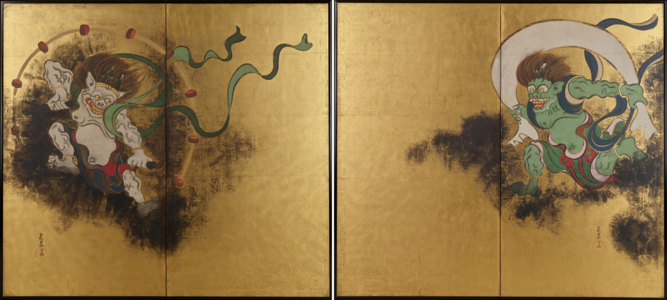


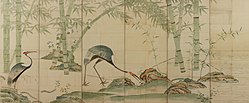



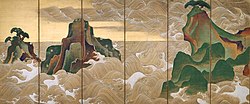





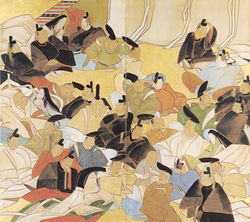
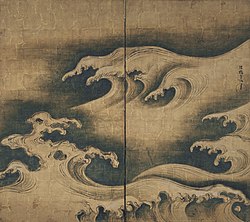





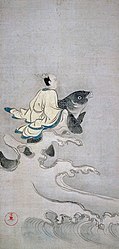
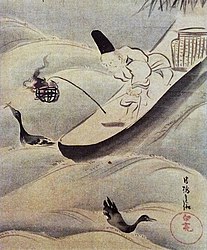


![Writing Box with Eight Bridges [ja] (National Treasure)](https://upload.wikimedia.org/wikipedia/commons/thumb/6/62/WritingBox_EightBridges_OgataKorin.JPG/250px-WritingBox_EightBridges_OgataKorin.JPG)

